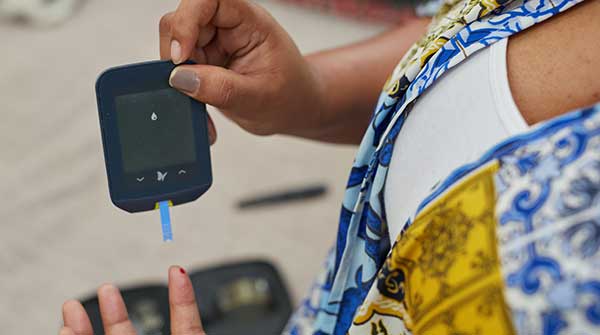People with Type 1 diabetes – including University of Alberta graduate student Jonathan Garfinkel – are using free instructions from the Internet to build an artificial pancreas.
The patient-led movement is pushing pharmaceutical companies to improve the treatments they offer, according to U of A diabetes expert Peter Light.
“Diabetics have developed, programmed and are now living on the most sophisticated form of insulin delivery currently available in the world,” said Garfinkel, a PhD candidate in the Faculty of Arts who is documenting his own experience as a Type 1 diabetic living through technological changes for his dissertation.
He joined a Facebook group and downloaded instructions on how to build The Loop, a system that uses a smartphone to connect his insulin pump and continuous glucose monitor. Rather than having to adjust his own insulin dose based on a finger prick blood glucose test, the system essentially closes the loop and makes the decisions for him, mimicking the function of a real pancreas.
The group has more than 21,000 followers and uses the hashtag #wearenotwaiting, in reference to their impatience for better commercially available diabetes management systems. There’s only one commercially available closed-loop system approved for use in Canada.
“What’s really interesting is that this bio-hacked loop system is actually outperforming many of the commercial products, and that’s driving the industry to make better products and to come out with them faster for regulatory approval,” said Light, a pharmacologist who is director of the Alberta Diabetes Institute and Dr. Charles A. Allard Chair in Diabetes Research.
“Within a few years, I think we will see mainstream, commercially available, Health Canada-approved systems that are better than the current versions.”
Light said he isn’t surprised by the patient-led movement to create better treatment options.
“I’ve known for a couple of years about parent groups who have hacked into their children’s glucose sensors so that they get a text when the child has low blood glucose levels, so they can call the teacher and make sure the child is safe,” Light said. “This is the logical next step.”
“This is a patient-led therapy,” said Garfinkel. “It’s free and was developed with a pay-it-forward mentality.”
“It’s kind of giving Health Canada and the pharmaceutical companies the middle finger,” he said.
“We patients aren’t angry, we’re just taking the initiative. We don’t want to wait for the industry to develop what we need.”
The Loop system is not illegal, Garfield pointed out, but neither is it government-sanctioned.
“Nobody is selling anything – it’s all open source,” he wrote in the Columbia University journal Intima: A Journal of Narrative Medicine.
“It’s changed my life,” he wrote.
Diabetes may double risk of developing depression by Dr. Paul Latimer
He used to have particular trouble controlling his diabetes overnight, waking up often with dangerously low blood sugar, causing confusion, sweating and insatiable hunger.
“For the past two years, since I’ve been on the Loop, I’ve had consistent overnight blood sugars,” Garfinkel said. “The technology has lessened the burden.”
Looking to technology to improve daily life
For Dyscorpia, a recent U of A art exhibit about the relationship between humans and machines, Garfinkel wrote about his hesitancy when he first learned about the Loop.
“The idea that a machine could make the decisions I had to make both appealed to me and frightened me,” he wrote. “To relinquish control to an algorithm created by diabetic software hackers?”
He decided to proceed despite his concern about the risks to his health if the Loop system failed and his blood sugar went too high or too low.
Garfinkel reflected that everyone is dependent on technology.
“We feel more ‘ourselves’ with our phones than without,” he wrote. “Through our Fitbits and Apple watches, we measure how many steps we take in a day, monitor heart rates, remind ourselves to breathe, sit, stand. So these watches and phones become extensions of ourselves.
“Granted, the stakes are higher for the practical cyborg living on Loop.”
Light said the Alberta Diabetes Institute will monitor the impact of the Loop on the development of diabetes management technology. He plans to continue the work of Mojgan Daneshmand, an engineer and Canada Research Chair in Radio Frequency Microsystems for Communication and Sensing, who was killed in the January 2020 Iran plane crash.
Light was working with Daneshmand to develop a more affordable glucose sensor that would sit on top of the skin, rather than being inserted subcutaneously. Light and his collaborators were recently awarded a U of A seed grant to pilot the project.
“A better glucose sensor is our ultimate goal,” Light said. “It’s high risk but potentially high reward, so we’re working on that project right now.”
Research also continues at the U of A to develop the next generation of the Edmonton Protocol, a breakthrough method of transplanting islet cells, which produce insulin in a healthy pancreas.
“Our researchers are trying to discover why the insulin-secreting cells are destroyed by a diabetic’s own immune system, how we can change the behaviour of the immune system so that they don’t reject their own cells, and how we can make better cells to put into people,” Light said.
“So instead of having to inject insulin, they would have a new supply of cells that would actually release insulin in response to blood glucose levels going up.”
Gillian Rutherford
This article originally appeared in the University of Alberta’s online publication Folio.
The views, opinions and positions expressed by columnists and contributors are the author’s alone. They do not inherently or expressly reflect the views, opinions and/or positions of our publication.




